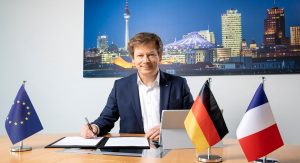 SNCF President Jean-Pierre Farandou and Richard Lutz the CEO of Deutsche Bahn together with Pierre Izard, SNCF Director for Technologies and Innovation, and Sabina Jeschke, DB board member for digitalisation and technology signed a new digitalisation cooperation, four years after the start of such agreement.
SNCF President Jean-Pierre Farandou and Richard Lutz the CEO of Deutsche Bahn together with Pierre Izard, SNCF Director for Technologies and Innovation, and Sabina Jeschke, DB board member for digitalisation and technology signed a new digitalisation cooperation, four years after the start of such agreement.
With the expansion of their partnership, the two companies are bundling their technological and digital know-how in order to make the railway system fit for the future.
“Our job is to help shape the future, to develop better services for our customers and to lay the foundations for a more efficient and robust railway. With this new partnership between our two countries, we are strengthening our innovation and technology programs to further advance the railways,” Jean-Pierre Farandou said.
The new agreement focuses on seven areas under which the automation of rail operations will be advanced, and the quality, performance and attractiveness of rail transport are to be increased. Even if the rail is already the most environmentally friendly means of transport, energy management and the reduction of carbon emissions are also among the topics of the digitalisation cooperation. The aim here is to accelerate the integration of new solutions and to meet the objectives of the European Green Deal.
“As two of the largest European railway companies, SNCF and DB face similar challenges and can therefore benefit from similar solutions. Our partnership with the SNCF is of great importance in this regard. It gives us the opportunity to jointly drive the implementation of European standards and initiatives and, at the same time, to exchange experiences and ideas within the framework of close cooperation. This is exactly what we need in order to further promote the integration of the European rail system,” Richard Lutz said.
The focus of the ongoing initiatives is the architecture of the future European rail system with the technological modules of autonomous trains, reliable train location, communication systems of the future 5G technology as well as intelligent rail operations using simulation methods and artificial intelligence (AI).
The two companies want to move faster in other key areas. They include digital freight transport with the improvement of cross-border data exchange, BIM (Building Information Modeling) for virtual construction planning and implementation on the basis of a digital twin, and traveler control with mobile apps. In addition, the companies have agreed to exchange experiences on alternative drive systems, such as the use of biofuels, hybrid solutions, and electric and hydrogen mobility. Another focus is environmentally friendly train stations. Important activities include the energy management, environmentally friendly building materials and resource conservation.
Through the increased digitalisation cooperation in the areas of research and development, the two railway companies are reaffirming their vision and their goal of jointly setting new standards and thus accelerating the European railway sector’s path into the future.
Share on:



